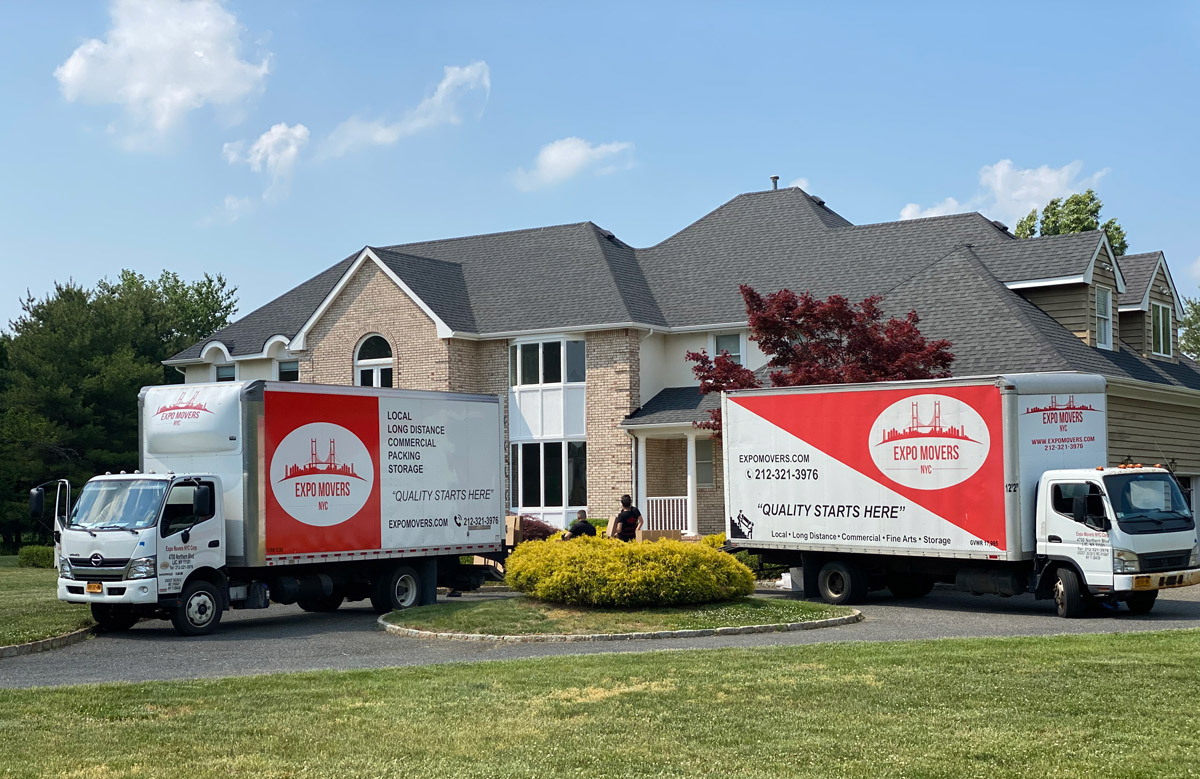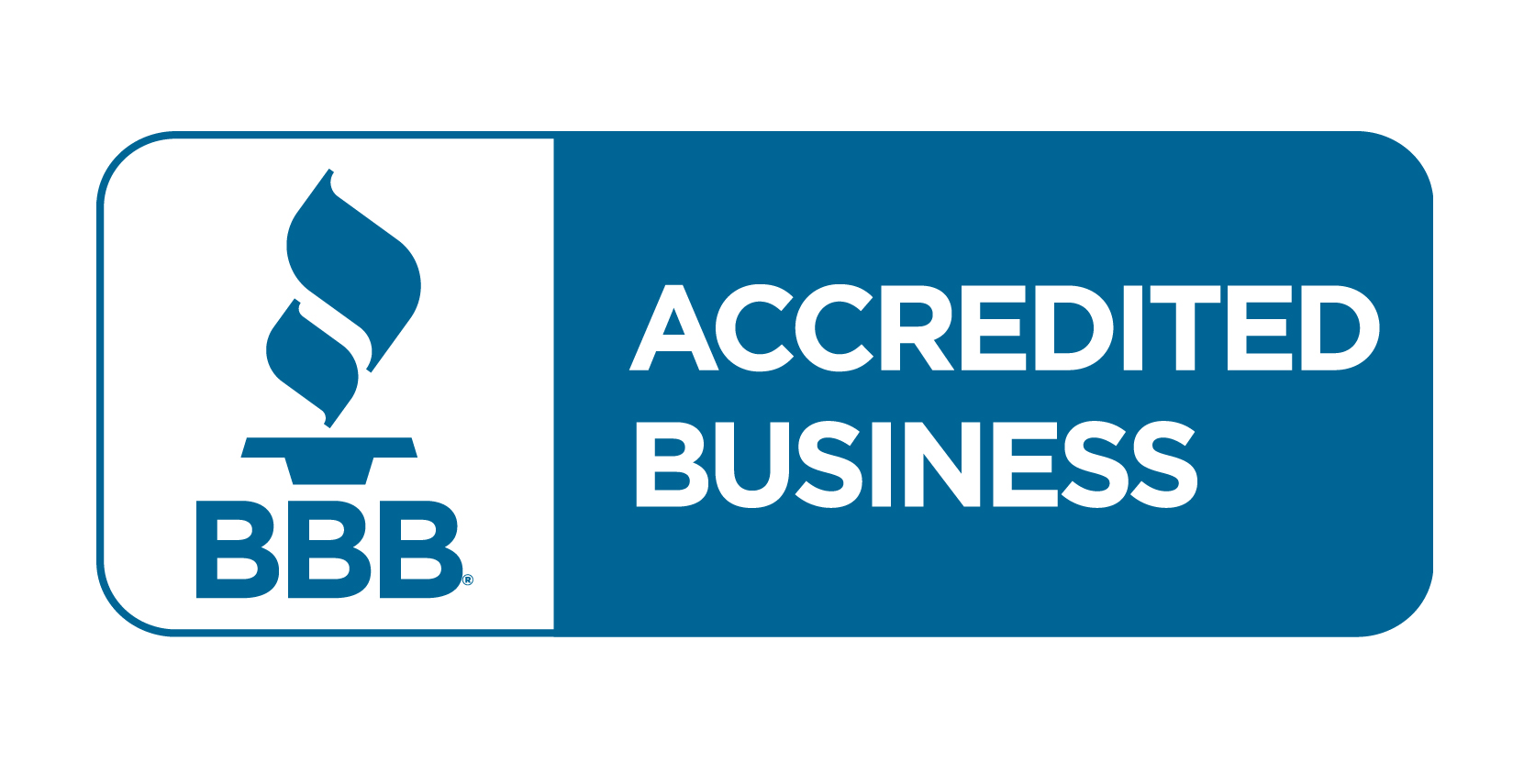In this guide, we’ll explore the best places to live in NYC with kids, highlighting a unique mix of well-known favorites and underrated enclaves (think affordability, green spaces, community feel, school quality, and safety). By the end, you’ll have a clearer picture of the top NYC neighborhoods for families – and some actionable tips to help you make the big move.
What Makes a NYC Neighborhood “Family-Friendly”?
When evaluating family-friendly neighborhoods in NYC, consider a few key factors. Safety is paramount – low crime rates and child-friendly streets are a must. School quality (both public and private) can vary block by block, so many parents research zoned school ratings or coveted magnet programs. Access to parks and playgrounds is another big plus – a local park becomes your backyard in NYC. Community vibe matters too: neighborhoods with libraries, mommy-and-me classes, and family-oriented events can make city life feel more small-town.
Finally, there’s the practical side: housing (do you prefer a doorman building with amenities, or a townhouse with a backyard?) and affordability (some areas command sky-high rents, while others still offer relative bargains). Keeping these factors in mind, let’s dive into some of NYC’s best family-friendly areas – each with its own flavor and appeal.
Park Slope, Brooklyn – The Classic Family Haven

Park Slope, Brooklyn is known for its tree-lined streets of brownstones and a family-centric atmosphere.
If you ask a New Yorker to name a kid-friendly neighborhood, Park Slope often tops the list. This Brooklyn enclave next to Prospect Park has long been considered a paradise for families. Strolling the sidewalks, you’ll see plenty of strollers, scooters, and friendly faces – it can feel like a small town of parents and kiddos within the big city. Park Slope’s public schools are among the city’s best, and there are also excellent private options and preschools (the local P.S. 321 and P.S. 107 are often praised by parents). Weekend mornings might find you at Prospect Park (literally the neighborhood’s backyard) for a picnic or a turn on the playground, followed by brunch at one of the many kid-friendly cafes on 5th or 7th Avenue. From music classes to dance studios and toddler art workshops, there’s no shortage of enrichment for little ones.
- Pros: Fantastic location by Prospect Park (endless outdoor space and a zoo), a ton of playgrounds and playrooms, top-notch schools and educational enrichment, a very safe feel with a strong community of families. Historic brownstones and peaceful, leafy streets make it charming and walkable. Boutiques, bookstores, ice cream shops – you name it, it’s family-oriented here.
- Cons: Cost of housing is high. Townhouses and condos in Park Slope are pricey – the average rent for a two-bedroom is around $3,800 (and can climb dramatically higher). Buying a brownstone will cost millions. Also, because it’s so popular, competition for school slots or daycares can be tough. While crime rates are low, petty property crimes do occur (about 879 per 100k people), so you still need city smarts. And if you’re looking for brand-new high-rise buildings with elevators, you won’t find many due to landmarking rules keeping development low-rise.
Amenities & Parks: Prospect Park is the crown jewel – offering playgrounds, sports fields, a lake for summer boating, winter ice skating, and the Prospect Park Zoo. The neighborhood is filled with pediatricians, family dentists, and the Park Slope Parents network (an online community) is a legendary resource for new moms and dads. You’ll also find the Brooklyn Public Library at Grand Army Plaza and plenty of indoor play spaces for rainy days. Farmer’s markets, kid-friendly restaurants, and year-round events (like the Halloween Parade) keep families entertained. It’s no wonder Park Slope feels like it’s made for kids – and for parents who want the very best of city living with a community twist.
Bay Ridge, Brooklyn – Small-Town Vibe in the Big City

Another Brooklyn standout, Bay Ridge offers a different – and refreshing – kind of family appeal. Tucked in southwestern Brooklyn along New York Harbor, Bay Ridge feels worlds away from the hustle of Manhattan. It’s often described as having a “small town in a big city” vibe. Here you’ll find a diverse mix of longtime locals and newer families, all enjoying a neighborhood where everyone knows your name (or at least your face at the local bagel shop). Public schools in Bay Ridge, such as P.S. 185 or P.S. 104, earn solid marks, and there’s a notable presence of parochial schools as well.
- Pros: Compared to trendier neighborhoods, Bay Ridge is more affordable for both renting and buying. An average two-bedroom rental is about $2,500 – a relative bargain for NYC. You get more space for your dollar, often even a small yard or a driveway (yes, some houses have driveways!). The area boasts excellent playgrounds and parks – Owls Head Park and Shore Road Park are local favorites for their waterfront views and spacious lawns. There’s a strong community spirit, with family-run restaurants (from Italian to Middle Eastern cuisine) and neighborhood fairs. It’s also pretty accessible: the R train runs through Bay Ridge, and express buses to Manhattan make commuting doable.
- Cons: The trade-off for being a bit removed is a longer commute if you work in Midtown or beyond (expect about an hour on the subway). Nightlife is low-key here – great for quiet nights, but teenagers might find it too sleepy. Also, no major museums or tourist attractions nearby, so some amenities of the city center require a trip. Lastly, while many see the somewhat slower pace as a plus, if you crave the buzz of the city, Bay Ridge might feel too isolated at times.
Community & Amenities: Bay Ridge has everything a family needs day-to-day: groceries, pediatric clinics, daycares, and lots of stroller-friendly restaurants. Third Avenue and Fifth Avenue are lined with eateries (many with kids’ menus) and ice cream shops. In summer, families flock to the 79th Street Boat Basin to watch the ships or catch the ferry. The neighborhood also throws beloved events like the annual Halloween Haunted Walk in Owl’s Head Park.
Importantly, Bay Ridge offers a sense of calm. You’ll see kids biking down tree-lined streets and neighbors chatting on their stoops – scenes you might expect in the suburbs, yet here you are in New York City. If you want a family neighborhood with a genuine community feel and relatively reasonable housing, Bay Ridge should be on your list.
Astoria, Queens – Diverse, Dynamic, and Kid-Friendly
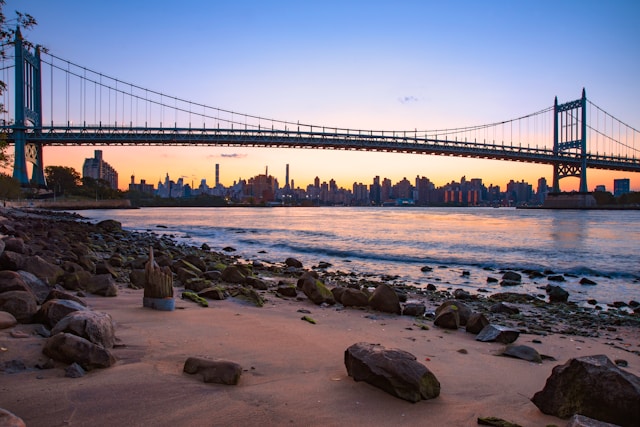
Astoria Park in Queens offers waterfront views, the city’s largest public pool, and plenty of green space for families in Astoria.
Queens has several family-friendly areas, but Astoria stands out for its mix of vibrant city life and suburban ease. Located in northwestern Queens along the East River, Astoria is a lively, safe, and diverse neighborhood known for its Greek and Italian roots (you’ll never run out of great food options here). What makes Astoria great for families is the balance it strikes: quieter residential blocks with tree-lined streets and ample park space, combined with bustling commercial strips where you’ll find everything from toy stores to international markets. On weekends, parents take their kids to Astoria Park, home to playgrounds, a skate park, and the famous Astoria Pool – NYC’s largest public pool. Schools in Astoria (like P.S. 122 or I.S. 10) are generally well-regarded, and the area’s many early childhood centers and playgroups cater to the younger set.
- Pros: Astoria offers lots of green space and recreation – aside from Astoria Park’s waterfront (with views of the RFK and Hell Gate bridges), there are smaller parks like Athens Square (which often has kids’ events) and Hoyt Playground. Culturally, it’s rich: the Museum of the Moving Image is a hit with older kids, and diverse restaurants mean your children grow up with a broad palate (families adore the local tavernas and gelato shops). The community is tight-knit and welcoming; many families have been here for generations, creating a neighborly feel. It’s also quite convenient: you can be in Midtown Manhattan in about 15–20 minutes via the N/W subway, making it easy to commute or plan museum outings. And compared to Manhattan or brownstone Brooklyn, Astoria’s housing costs are moderate – the median rent for a two-bedroom is around $3,500, and many apartments are spacious (some even in smaller multi-family homes with a backyard).
- Cons: As Astoria’s popularity has grown, so has development – meaning some new high-rise condos and increasing rents in certain pockets. It’s not cheap cheap, just cheaper than Manhattan. If you’re looking for a quiet suburban vibe, note that parts of Astoria are directly under flight paths from LaGuardia Airport (noise can be an issue nearer the water). Also, streets closer to the main avenues (like Steinway or Broadway) can be busy and lack that quiet charm found deeper into Queens. Lastly, while there are many playgrounds, big private yards are rare; like most of NYC, you’ll rely on parks for outdoor play.
Local Highlights: A huge perk of Astoria is the array of family activities available. You’ve got kids’ birthday venues like Bounce ‘N Play for indoor fun and dance schools and martial arts studios aplenty. In summer, Astoria Park hosts free outdoor movies and concerts that families enjoy together. The Astoria Park Shorefest turns the waterfront into a fairground each year. For daily life, there are pediatric clinics and the Mount Sinai Queens hospital nearby, so healthcare is handy. Astoria also has easy access to the NYC Ferry at Astoria Landing – a fun way to take the kids on a boat ride to Manhattan or Brooklyn. In short, Astoria combines culture, convenience, and community – a formula that lands it on many lists of top NYC neighborhoods for families.
Forest Hills, Queens – Suburban Tranquility Within the City
If you’re seeking a more tranquil environment without leaving NYC, Forest Hills might be your dream come true. Tucked in central Queens, just a quick subway or Long Island Rail Road ride from Manhattan, Forest Hills manages to feel like a suburb in the city. Picture quiet streets lined with Tudor-style homes, top-notch schools, and even yards and driveways – yes, really – plus a main shopping street that’s walkable and convenient. Many families choose Forest Hills for its balance: it’s quiet and safe enough to raise kids (the area’s crime rates are very low), yet you’re only about 20-30 minutes from Midtown via the E/F/M/R subway lines or LIRR. It’s no surprise that young families are flocking here, drawn by slightly more space and slightly lower prices than Manhattan. In fact, the median rental price in Forest Hills hovers around $2,500 for a two-bedroom – quite reasonable by NYC standards, which means many young couples move here to gain an extra bedroom for a nursery.
- Pros: Great schools are a big draw – Forest Hills is home to well-regarded public schools (like P.S. 196 and Forest Hills High School) and also near elite private schools in adjacent neighborhoods. The community is very family-oriented; trick-or-treating on Halloween is a major event on certain blocks, and there are plenty of family-run businesses. Forest Park, one of NYC’s larger parks, is just next door – offering playgrounds, a carousel, biking trails, even horseback riding for kids who love animals. The neighborhood is also extremely commuter-friendly: not only do you have subways, but many residents take advantage of the LIRR, which can get you to Penn Station in about 15 minutes – great for parents working in the city. Housing is a mix: you can find doorman apartment buildings, cute co-ops, and even detached houses with backyards in the Forest Hills Gardens section.
- Cons: Forest Hills can be a bit sleepy in terms of nightlife or big attractions – you won’t find major museums or a buzzing bar scene (though Austin Street has plenty of restaurants and a few pubs). While many see the quiet as a pro, teenagers or those craving city excitement might find it too tranquil. Also, while it’s more affordable than Manhattan, it’s pricier than some farther-out Queens areas – you pay a premium for the convenience and reputation, especially in the private community of Forest Hills Gardens. Parking can be tough on certain blocks (though many buildings have garages). Lastly, some parts of Forest Hills have older buildings – charming, but possibly lacking the amenities (like central AC or modern gyms) that new constructions in Long Island City or Manhattan might have.
Neighborhood Charm: One step onto Station Square (the historic plaza by the LIRR station) and you might forget you’re in New York City. There’s a real storybook charm here, from the architecture to the community events. Families enjoy concerts and summer Shakespeare in the Park performances at Forest Hills Stadium, and the local farmers’ market on Sundays is a hit for fresh produce and artisan goods. Austin Street serves as the commercial heart, with everything from Target and kid-oriented boutiques to ice cream parlors and casual eateries. Many of these businesses have been around for decades, giving a sense of stability. If you want to stay in NYC but crave a bit of a suburban lifestyle (complete with good schools, green spaces, and a close-knit community), Forest Hills deserves a spot among the best places to live in NYC with kids.
Upper West Side, Manhattan – Culture and Central Park at Your Doorstep
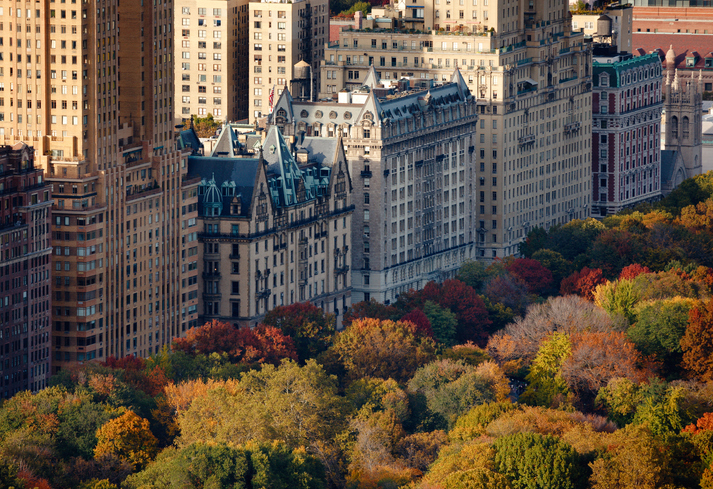
Afternoon light on Central Park’s treetops and NYC buildings. Upper West Side building facades and tree colors lit by the autumn sun.
When it comes to Manhattan, the Upper West Side (UWS) is practically synonymous with family living. This sprawling neighborhood – from Central Park West to the Hudson River, roughly 59th to 110th Street – offers an appealing blend of urban convenience and kid-friendly amenities. In fact, many would say the Upper West Side is a “paradise for families”. Why?
For starters, you have Central Park forming the eastern border and Riverside Park lining the west – meaning playgrounds, sports fields, and nature are never more than a few blocks away. The UWS is also home to institutions like the Children’s Museum of Manhattan and the American Museum of Natural History, so weekend adventures are built right into the neighborhood. Schools are a highlight: there are dozens of them, including some of NYC’s top public schools (P.S. 87, P.S. 199) and elite privates (Trinity, Collegiate, Ethical Culture Fieldston’s lower school). The vibe here is affluent yet laid-back – you’ll see as many families in yoga pants and strollers as you will power brokers in suits.
- Pros: Everything is at your fingertips. Need a last-minute birthday gift? Stroll to the nearest bookstore or toy store on Broadway or Columbus. Want to have a picnic? Central Park’s grassy Sheep Meadow is a quick walk. The Upper West Side’s abundance of family-oriented restaurants (many with stroller parking and kids’ menus) makes dining out feasible. It’s also one of the safest parts of Manhattan. Many streets are lined with picturesque brownstones giving a small-town feel amidst the city. Residents here tend to be highly educated and involved in the community – don’t be surprised if your neighbors are organizing a school fundraiser or a block party. Transportation is easy: multiple subway lines (1/2/3, B/C) run north-south, and buses cross town, so getting around with a stroller is doable. Housing options range from classic pre-war apartments to modern high-rises, so families can choose what suits them.
- Cons: The cost. The Upper West Side is one of NYC’s priciest residential areas. An average rent for a two-bedroom is around $5,500, and larger family-sized condos routinely cost millions to buy. Space is at a premium; unless you have a big budget, you might compromise on square footage. Another consideration: the popularity means crowded playgrounds and competition for preschool spots (it’s not unheard of for parents to apply to nursery schools shortly after a baby is born!). Parking a car is very difficult (most families here don’t have one, relying on subways, buses, or walking). Finally, while it’s generally peaceful, you are still very much in the city – it’s busy, sometimes noisy, and you’ll need to keep a close eye on kids in crowds or near traffic.
Family Lifestyle: One iconic scene on the UWS is the Saturday morning ritual of families heading to Zabar’s (the famous deli) or Barney Greengrass for bagels, then off to kiddie classes or sports practice. The neighborhood has myriad classes for children – from ballet to coding – often held at local community centers or the JCC (Jewish Community Center) on 76th Street. Speaking of the JCC, it’s a hub for many UWS families, offering everything from swimming lessons to parenting workshops. For outdoor fun, aside from Central Park’s wonders, Riverside Park provides miles of biking/scootering paths and playgrounds with river views. The sense of history and culture on the UWS is rich – imagine telling your kids bedtime stories after a day at the dinosaur exhibits in the Natural History Museum, which is basically in your backyard. If you can swing the cost, the Upper West Side truly encapsulates the best of Manhattan family living: convenience, culture, and a community vibe in the heart of the city.
Upper East Side, Manhattan – Posh, Safe, and School-Ready

Photo of Streets and Buildings of Upper East Site of Manhattan, New York City
Just across Central Park, the Upper East Side (UES) has its own claim to family-friendly fame. This is a more classic, upscale neighborhood – traditionally known for its wealthy residents and world-class museums – but it’s also crawling with kids (in a good way!). The UES is one of the safest neighborhoods in NYC, with low crime and a clean, polished environment. For families, a major draw is the sheer concentration of top-tier schools. The area is home to some of the city’s most prestigious private schools – think The Dalton School, Spence, Chapin, Brearley – as well as high-performing public schools like P.S. 6 and P.S. 290 (which have strong reputations and involved PTAs). The neighborhood spans from 59th Street up to 96th (or 110th) Street, east of Central Park over to the East River. Within that, sub-areas like Carnegie Hill are especially known for a family-centric feel (and being stroller-central on weekends).
- Pros: The Upper East Side offers peace of mind – it’s clean, safe, and full of amenities that cater to families. You have Central Park as your western boundary (with the wonderful East 96th St. playground, the Central Park Zoo, and countless spots for play) and Carl Schurz Park to the east (a neighborhood gem along the river, with its own playgrounds and even a dog run for pet-loving families). Pediatricians and specialty child services abound – many families here have a go-to pediatrician within a few blocks. The abundance of doorman buildings means extra security and sometimes perks like playrooms or swimming pools. The UES also has cultural riches to enrich your kids’ lives: you’re on Museum Mile, with the Met, Guggenheim, and more (some families pop into these institutions as casually as a playground visit). For day-to-day, everything is convenient: supermarkets, bakeries, bookstores (the famous Children’s Bookstore on Lexington), and toy shops are readily at hand.
- Cons: Affordability (or lack thereof). The Upper East Side can be extremely expensive. Townhouses and luxury high-rise apartments in this area are among the priciest in the nation. The median rent is cited around $9,000 a month– though you can find smaller or older units for less, it gives a sense of the premium here. Dining and shopping skew upscale, which can mean higher prices (though there are still family-run pizza joints and bagel places if you know where to look). Also, the UES historically had limited subway access in the far East (though the Second Avenue Subway has improved this). Some parts of the UES, especially east of Third Avenue, feel a bit farther from subways – manageable with kids if you use buses or don’t mind a walk, but something to note (stroller + subway steps can be challenging). Lastly, the social scene can be a bit high-pressure; some jokingly talk about the “stroller wars” or competitive parenting. It’s a bit caricatured, but in circles where many hire nannies and vie for private school spots, you might encounter a more fast-paced parenting culture.
Neighborhood Perks: One advantage of the UES is that despite its posh reputation, it truly caters to children. You can spend a rainy day at Interactive play spaces like The Children’s Museum of Manhattan’s Upper East Side outpost or art classes at Little Picasso. Many cafes have space for strollers, and a lot of local restaurants offer kids-eat-free nights to attract neighborhood families. Fitness-minded parents love strolling/jogging in Central Park or along the East River Esplanade with a view of Roosevelt Island. And if you’re a parent who also values grown-up culture, having the Metropolitan Museum of Art as a place to take your toddler (many parents bring young kids to the Met for an “art walk” to burn energy) is pretty awesome. In short, the Upper East Side can offer an elite family experience – world-class education, abundant parks, safety – if your budget permits and you’re drawn to its polished atmosphere.
Battery Park City, Manhattan – Suburban Serenity by the Hudson

A scenic view of empty blue chairs in green Battery Park in New York City, United States.
Families enjoying the green lawn at Rockefeller Park in Battery Park City, with modern apartments in the background.
For those who want a modern, planned neighborhood built with families in mind, Battery Park City (BPC) is a top contender. Tucked at the southwestern tip of Manhattan along the Hudson River, BPC was developed in the 1970s-80s on reclaimed land and feels nothing like the rest of the city – in fact, living here often feels like you’ve “escaped the big city to a suburb,” yet you’re still in Manhattan. It’s an enclave of sleek high-rise apartments and landscaped parks, set apart from the hustle by West Street. Families love BPC for its tranquility, safety, and kid-focused amenities. Crime is extremely low, and it’s said to have the best public school district in Manhattan (zones that feed into excellent schools like P.S./I.S. 276 and P.S. 89). The entire neighborhood is along the waterfront, giving you beautiful views and fresh air. On any given day, you’ll see kids learning to scooter on the riverfront esplanade, parents jogging with strollers, and families enjoying the numerous playgrounds.
- Pros: Battery Park City is purpose-built for comfortable family living. There are multiple wonderful parks and playgrounds in walking distance – Rockefeller Park (with its large lawn and playground), Teardrop Park (a hidden gem with unique play features) and West Thames Park, to name a few. Because the area is relatively new, buildings are modern: that means things like elevators, doormen, gyms, playrooms, and in-unit laundry are common (a luxury in NYC). Many apartments have views of the Hudson River or the Statue of Liberty, which can be magical for kids (“goodnight Statue of Liberty!” might be part of bedtime). The community is very active; local parents often know each other from the neighborhood kids’ classes and events – think story times, puppet shows, and seasonal family concerts. BPC also has its own branch of the public library and easy access to facilities like the Asphalt Green Battery Park City (offering swim classes, sports, etc.). Despite its tucked-away feel, transportation is still convenient: the 1, R/W, and PATH trains, plus ferries at World Financial Center, connevdct you to the rest of NYC. And for Manhattan, the value is decent – the median rent (~$3,500) is often lower here than uptown.
- Cons: BPC can feel a bit insular or isolated to some – it is geographically separated by a highway from the rest of Tribeca/FiDi. If you want to grab dinner in, say, the East Village, it’s a bit of a trek. Some people find the vibe a little too planned or sterile (it’s very clean and can feel almost like a gated community without the gate). Also, because it’s all post-70s construction on leased land, buying property here can have complexities (ground leases, etc.) – something to research if you plan to purchase. The dining and shopping options within BPC itself are somewhat limited (though adjacent Tribeca and FiDi fill the gap easily). Finally, while there are good public schools, if you’re set on private schooling, note that most of Manhattan’s top private schools are uptown – meaning a commute for your child if that’s your route.
Family Fun: Battery Park City shines in providing a leisurely family lifestyle. On weekends, you might walk/bike along the Hudson River Greenway, stopping at the Battery Park City Ball Fields where little leagues play. In summer, kids run through sprinklers with the river breeze cooling the air. The area also hosts the Poets House Children’s Room for literary activities and the New York Kids Club which even offers occasional pajama parties for kids(so parents can have a date night). Around the winter holidays, the Battery Park City community organizes festive events and tree-lightings. And whenever you do crave the rest of Manhattan, the subways outside your peaceful bubble are only a short walk away. In summary, Battery Park City offers an oasis-like, almost suburban experience right within the city – low crime, new amenities, parks galore – making it unquestionably one of the top NYC neighborhoods for families seeking calm and convenience.
Great Kills, Staten Island – Suburban Space and Outstanding Schools
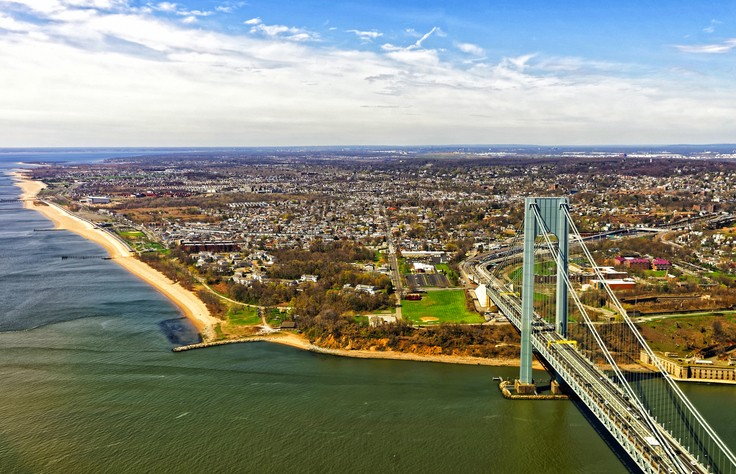
Aerial view on Verrazano-Narrows Bridge over the Narrows. It connects Brooklyn and Staten Island. Narrows is strait connecting Upper Bay with Lower Bay. View on Fort Wadsworth in Staten Island
When discussing NYC, people often forget about Staten Island – but savvy families know that Staten Island offers some of the most spacious and suburban-style living in the city. If you’re open to living outside the typical “city” environment, areas like Great Kills (and nearby neighborhoods on the South Shore like Huguenot and Tottenville) provide an ideal setting for kids. Great Kills, in particular, is often cited as one of the most family-friendly spots in Staten Island. Why? It has very low population density (about 4,700 people per square mile – a fraction of Manhattan’s density), meaning quieter streets, less traffic, and even private backyards. The neighborhood is also noted for being exceptionally safe – it boasts much lower crime than most NYC neighborhoods. Perhaps the biggest draw: schools in Great Kills are excellent, often outperforming national averages. Many NYC families who want a classic suburban upbringing (think little league, backyard barbecues, driveways) without leaving the five boroughs end up here.
- Pros: Space, space, space. In Great Kills you can find single-family homes, often detached, with front lawns and garages – something practically unheard of in other boroughs. Kids can actually play in their own yard. The community is tight-knit and many residents have been there for years, fostering a true neighborhood feel. Staten Island’s parks are fantastic: the sprawling Greenbelt is nearby for hikes, and Great Kills Park (part of the Gateway National Recreation Area) offers beaches, a marina, and nature trails. The public schools (like P.S. 37, or I.S. 24) are highly rated; there are also Catholic schools and a large high school, Staten Island Tech, not far away, known for academic excellence. Great Kills has a suburban commercial strip with diners, pizzerias, and shops where owners greet you by name. And here’s a shocker for NYC: housing costs are significantly lower. The average rent around $1,400, and many families choose to buy homes here since prices are more attainable. Most households are owner-occupied, indicating families put down roots.
- Cons: The commute from Staten Island into Manhattan or other boroughs can be lengthy. There’s no subway connection to the rest of NYC (Staten Island has its own rail line, but otherwise you rely on buses, the Staten Island Ferry, or driving). For parents working in Manhattan, the ferry ride is scenic but adds time. Teenagers might crave more excitement – while Great Kills is wonderful for younger kids, older ones might find the suburban setting limiting compared to the city buzz elsewhere. Car dependency is real here: unlike Manhattan, you’ll likely want a car to do grocery runs or shuttle kids to activities (public transit exists but is less convenient). Lastly, moving to Staten Island can feel like a bigger cultural jump – you’re not in the “mix” of NYC’s hustle daily, which for some is a relief and for others, a drawback.
Lifestyle: Living in Great Kills means your family weekends could include biking along the coastline, joining a local Little League team, or visiting the Staten Island Zoo (yes, the borough has a cute zoo!). The pace is slower – neighbors chat over fences, and there’s a strong community sense. Staten Island’s Annual FerryHawks baseball games, local festivals, and historic Richmond Town events give families plenty to do. Also, you have ample shopping centers with parking (no lugging strollers up subway stairs after a Target run!). In short, Great Kills and similar Staten Island neighborhoods provide a true suburban experience within NYC: if you prioritize space, affordability, and a traditional neighborhood feel – and don’t mind a commute – this borough might be your family’s best bet.
Conclusion: Finding Your Perfect NYC Neighborhood
Choosing the best place to live in NYC with kids ultimately comes down to your family’s needs and priorities. As we’ve seen, there’s a huge range of family-friendly neighborhoods NYC offers – from the brownstone-lined blocks of Park Slope to the quiet cul-de-sacs of Staten Island. To find your fit, consider making a checklist: What are your non-negotiables (be it a short commute, a yard, or a top public school)? Which trade-offs are you willing to accept? For example, you might sacrifice apartment size to be steps from Central Park, or swap a quick Manhattan commute for a backyard and great schools in Queens or Staten Island. Actionable tips for families moving to NYC:
Visit at different times. Once you have a shortlist of neighborhoods, visit them with your kids on weekends and weekdays. A place that’s serene on Sunday might be too hectic during rush hour, or vice versa.
Talk to other parents. Join local Facebook groups or community boards (many neighborhoods have parent groups, like Park Slope Parents or Astoria Moms). First-hand experiences will give you insight into what day-to-day life is really like.
Research schools and zoning early. If public schools are important to you, check the zones and quality. NYC’s Department of Education website has a school finder tool and performance stats. Popular schools can drive micro-neighborhood decisions (some families choose an apartment specifically for a certain school zone). Also, look into pre-K and daycare options in the area; in some neighborhoods, waitlists can be long, so it’s good to plan ahead.
Consider the commute and transit options. A family outing is easier when you have multiple subway lines or buses nearby. If you have a car, scout out parking situations or the availability of garages. For example, living in Battery Park City might be dreamy, but are you okay with using the ferry or subway to visit friends uptown? Make sure the transit trade-off works for you.
Balance budget with quality of life. It’s easy to be wowed by a neighborhood’s reputation, but keep an eye on your housing budget. Sometimes a slightly less famous neighborhood (hello, Bay Ridge or Forest Hills) can offer an amazing lifestyle at a fraction of the cost of the trendier spots. Think about where you’ll get the most value – whether that’s space, amenities, or community support – for your rent or mortgage dollar.
Finally, trust your gut. New York City is huge and incredibly diverse – there’s no one-size-fits-all “best” neighborhood. The best NYC neighborhood for your family is the one that feels like home. Whether you picture morning walks in Central Park, block parties on a Brooklyn street, or a backyard barbecue in Staten Island, there’s an area that matches your vision. Take your time, do your homework, and you’ll discover a community that welcomes you and your children with open arms. Remember, millions of happy kids have grown up in NYC’s concrete jungle – your family can thrive here too, in whatever borough or neighborhood you choose. Welcome to New York, and happy house-hunting!




